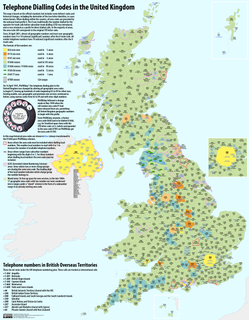Wide Area Telephone Service (WATS) was a flat-rate long-distance service offering for customer dial-type telecommunications in some of the countries that adhere to the North American Numbering Plan. The service was between a given customer phone and stations within specified geographic rate areas, employing a single telephone line between the customer location and the serving central office. Each access line could be arranged for outward (OUT-WATS) or inward (IN-WATS) service, or both.

The North American Numbering Plan (NANP) is a telephone numbering plan for twenty-five regions in twenty countries, primarily in North America and the Caribbean. This group is historically known as World Zone 1 and has the international calling code 1. Some North American countries, most notably Mexico, do not participate in the NANP.
A toll-free telephone number or freephone number is a telephone number that is billed for all arriving calls instead of incurring charges to the originating telephone subscriber. For the calling party, a call to a toll-free number from a landline is free of charge.

Telephone numbers in the United Kingdom are administered by the Office of Communications (Ofcom). For this purpose, Ofcom established a telephone numbering plan, known as the National Telephone Numbering Plan, which is the system for assigning telephone numbers to subscriber stations.
The Australian telephone numbering plan describes the allocation of phone numbers in Australia. It has changed many times, the most recent major reorganisation by the Australian Communications & Media Authority taking place between 1994 and 1998.

Telephone numbers in the Netherlands are administered by the Ministry of Economic Affairs, Agriculture and Innovation of the Netherlands and may be grouped into three general categories: geographical numbers, non-geographical numbers, and numbers for public services.
In telecommunications, a long-distance call (U.S.) or trunk call is a telephone call made to a location outside a defined local calling area. Long-distance calls are typically charged a higher billing rate than local calls. The term is not necessarily synonymous with placing calls to another telephone area code.
In Argentina, area codes are two, three, or four digits long. Local customer numbers are six to eight figures long. The total number of digits is ten, for example, phone number (11) 1234-5678 for Buenos Aires is made up of a 2-digit area code number and an 8-digit subscriber's number, while (383) 123-4567 would be an example of a Catamarca number.
Number pooling is a method of reallocating telephony numbering space in the North American Numbering Plan, primarily in growth areas in the United States.
Direct inward dialing (DID), also called direct dial-in (DDI) in Europe and Oceania, is a telecommunication service offered by telephone companies to subscribers who operate a private branch exchange (PBX) system. The feature provides service for multiple telephone numbers over one or more analog or digital physical circuits to the PBX, and transmits the dialed telephone number to the PBX so that a PBX extension is directly accessible for an outside caller, possibly by-passing an auto-attendant.
The Big Number Change addressed various issues with the telephone dialling plan in the United Kingdom, during the late-1990s and early-2000s.

Numbers on the Irish telephone numbering plan are regulated and assigned to operators by ComReg.

The dialling plan for mobile networks and new landline operators is closed; all subscriber numbers must be dialled in full. For landline numbers starting with 02, the dialling plan used to be open; the trunk digit and area code could be omitted if the caller was in the same area code as the callee. However, starting May 3, 2008, all landline numbers must be dialled in full.
The Brazilian telephone numbering plan uses a two-digit area code plus eight-digit local phone numbers for landlines and nine digits for mobile lines. Public utility services use short phone numbers, always starting with 1.
In the North American Numbering Plan, a RespOrg is a company that maintains the registration for individual toll-free telephone numbers in the distributed Service Management System/800 database. Their function in North American telephony is analogous to that of an individual registrar in the Internet's Domain Name System.

The Spanish telephone numbering plan is the allocation of telephone numbers in Spain. It was previously regulated by the Comisión del Mercado de las Telecomunicaciones (CMT), but is now regulated by the Comisión Nacional de los Mercados y la Competencia (CNMC).

The regulation of telephone numbers in Germany is the responsibility of the Federal Network Agency of the German government. The agency has a mandate to telecommunications in Germany and other infrastructure systems.
The national conventions for writing telephone numbers vary by country. While international standards exist in the form of the International Telecommunication Union sector ITU-T issued recommendation E.123, national telephone numbering plans define the format and length of telephone numbers assigned to telephones.
In the United States of America, Canada, and other countries participating in the North American Numbering Plan, a toll-free telephone number has one of the area codes 800, 833, 844, 855, 866, 877, and 888.
Somos, Inc., is a company that manages registry databases for the telecommunications industry. Additionally, since January 1, 2019, the company has been the North American Numbering Plan Administrator, under a contract granted by the Federal Communications Commission.






